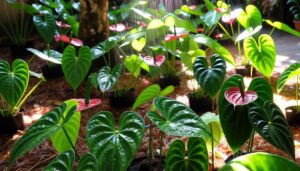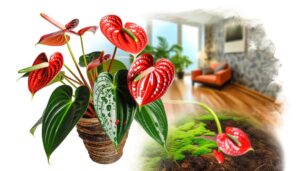Care Guide to Prevent Yellow Leaves on Anthurium
To prevent yellow leaves on your Anthurium, water when the top inch of soil is dry using room-temperature water. Make sure the pot has proper drainage to avoid root rot.
Place the plant in bright, indirect sunlight and maintain temperatures between 70-85°F. Use well-draining soil enriched with organic matter like peat moss.
Maintain 70-80% humidity, monitoring with a hygrometer, and use a balanced, water-soluble fertilizer. Regularly check for pests and diseases, treating with insecticidal soap or fungicides as needed.
Prune yellow or dead leaves, sterilizing your tools with isopropyl alcohol. For best results, continue exploring these guidelines.

Key Takeaways
- Water Anthurium when the top inch of soil is dry to prevent overwatering and root rot.
- Provide bright, indirect sunlight to ensure proper photosynthesis and avoid photodamage.
- Maintain a consistent temperature between 70-85°F during the day and above 60°F at night.
- Use well-draining soil with perlite and orchid bark to avoid waterlogged roots.
- Regularly inspect and prune dead or yellowing leaves to maintain plant health.
Proper Watering Techniques
Optimizing proper watering methods involves understanding the specific hydration needs of Anthurium plants to prevent leaf chlorosis.
You should maintain an ideal moisture level by using well-draining soil to avoid waterlogging, which can lead to root rot and nutrient deficiencies. Check the top inch of the substrate; if it feels dry, it's time to water.
Use distilled or rainwater to prevent mineral accumulation and avoid water with high fluoride content. Consistent watering schedules are vital, and you should monitor humidity levels, aiming for around 70-80%. Employ a hygrometer for accuracy.
During winter, reduce watering frequency to accommodate slower growth rates. Proper watering ensures the plant's physiological processes, such as photosynthesis and nutrient uptake, function effectively, preventing yellowing leaves.
Ideal Light Conditions
Best light conditions for Anthurium involve providing bright, indirect sunlight to maximize photosynthesis without causing photodamage to the foliage. Direct sunlight can lead to photoinhibition, where the photosynthetic apparatus is damaged, resulting in chlorosis or yellowing of the leaves. Position your Anthurium near an east-facing window or use sheer curtains to diffuse intense light.
Insufficient light can also hinder chlorophyll production, causing etiolation and leaf discoloration. Utilize a light meter to ensure best light levels between 10,000 to 20,000 lux. If natural light is inadequate, supplement with fluorescent or LED grow lights, maintaining a photoperiod of 12-16 hours.
Consistent light conditions are important for maintaining the plant's physiological processes and preventing stress-induced leaf yellowing.
Soil and Potting Mix
To prevent yellow leaves on your Anthurium, make sure you're using a well-draining soil mix that incorporates components like perlite and orchid bark to optimize aeration.
Incorporate organic matter such as peat moss or compost to maintain moisture retention without waterlogging the roots.
Additionally, select a pot with adequate drainage holes to facilitate proper water flow and prevent root rot.
Well-Draining Soil Mix
Do you know that a well-draining soil mix is essential for preventing waterlogged roots and the subsequent yellowing of Anthurium leaves?
You've got to make sure your substrate has a balanced composition of aeration and moisture retention. Utilize a mix comprising 30% orchid bark, 30% peat moss, and 40% perlite.
Orchid bark promotes aeration, preventing root suffocation. Peat moss retains moisture without becoming waterlogged, and perlite enhances drainage while maintaining soil structure.
This combination mitigates conditions conducive to root rot, ensuring ideal oxygenation and nutrient uptake. By using this scientifically balanced mix, you'll prevent the physiological stress that manifests as chlorosis, or yellowing, in Anthurium leaves.
Organic Matter Addition
In addition to a well-draining soil mixture, incorporating organic material such as compost or aged manure into the potting mixture can greatly improve nutrient availability and soil structure for your Anthurium. Organic material enhances cation exchange capacity (CEC), which enhances the soil's ability to retain essential nutrients like potassium and magnesium. This supports a balanced nutrient profile, crucial for preventing chlorosis and yellowing leaves.
It also enhances soil aeration, reducing the risk of root rot. Make sure the organic material is well-decomposed to avoid nitrogen immobilization, which can deprive your Anthurium of necessary nitrogen. A balanced mix of 20-30% organic material will provide ideal growth conditions, promoting vibrant and healthy foliage. This strategic addition strengthens the plant's resilience against environmental stressors.
Proper Pot Selection
Choosing the appropriate container for your Anthurium is crucial, as it secures ideal soil aeration and proper drainage, minimizing the risk of waterlogged roots. Guarantee the pot has drainage holes to thwart water buildup.
Utilize a potting mix rich in organic matter, incorporating materials like pine bark, perlite, and peat moss to encourage aeration and moisture retention.
Follow these steps:
- Select a well-draining container: Opt for a pot with multiple drainage holes.
- Prepare a suitable potting mixture: Mix equal parts of pine bark, perlite, and peat moss.
- Monitor root health: Repot every 1-2 years to refresh soil and prevent root-bound conditions.
This secures ideal conditions for nutrient absorption and root health, avoiding yellowing leaves.
Humidity Requirements
Maintaining ideal humidity levels is essential for Anthurium health, as these tropical plants thrive in environments with relative humidity between 70% and 80%. Use a hygrometer to monitor ambient moisture, ensuring it remains within this best-suited range.
If humidity drops below 60%, utilize a humidifier to elevate levels. Alternatively, employ a pebble tray filled with water beneath the plant pot, which facilitates evaporation and increases local humidity. Misting the leaves can also temporarily boost moisture but should be done sparingly to prevent fungal issues.
In homes with central heating or air conditioning, consider grouping plants together to create a microenvironment with higher humidity. Consistently maintaining these conditions will prevent leaf desiccation and chlorosis, ensuring vibrant, healthy Anthurium foliage.
Fertilizing Tips
Regularly providing Anthurium with a balanced, water-soluble fertilizer containing equal parts nitrogen, phosphorus, and potassium (N-P-K) promotes vigorous growth and prevents nutrient deficiencies. Aim for an N-P-K ratio of 20-20-20. Fertilize bi-weekly during the growing season for best results.
Over-fertilizing can lead to salt buildup, causing root damage and yellow leaves.
To avoid this, follow these guidelines:
- Dilution: Mix the fertilizer at half the recommended strength to prevent nutrient overdose.
- Timing: Apply fertilizer in the morning when plant metabolic rates are higher.
- Leaching: Periodically flush the soil with water to remove excess salts and prevent accumulation.
Temperature Control
Ensuring that your Anthurium thrives involves maintaining an ideal temperature range of 70-85°F (21-29°C) during the day and not dropping below 60°F (15°C) at night. Temperature fluctuations outside this range can induce physiological stress, leading to chlorosis, where leaves turn yellow due to disrupted chlorophyll synthesis.
Utilize a reliable thermometer to monitor ambient conditions. Avoid placing your Anthurium near drafty windows, heating vents, or air conditioning units, as these can cause rapid temperature shifts. If you live in a colder climate, consider using a heat mat to stabilize root temperatures.
Consistent thermal regulation aids in optimum metabolic processes, ensuring nutrient uptake and overall plant vigor. Proper temperature control is critical for preventing yellow leaves and promoting robust Anthurium health.
Pest and Disease Management
Effective pest and disease management for your Anthurium involves identifying common threats such as aphids, spider mites, and fungal infections early to implement targeted treatments. Aphids and spider mites can cause chlorosis, leading to yellow leaves. Use insecticidal soap or neem oil to eradicate these pests.
For fungal infections like root rot caused by Phytophthora spp., ensure proper drainage and avoid waterlogging. If infection occurs, apply fungicides containing copper oxychloride or thiophanate-methyl.
Here's a quick guide:
- Inspect regularly: Check leaves and stems for signs of pests or disease.
- Apply treatments: Use appropriate insecticides or fungicides as needed.
- Maintain hygiene: Sterilize tools and dispose of infected plant material properly.
Implement these strategies to maintain a healthy Anthurium.
Pruning and Maintenance
Pruning your Anthurium involves selectively removing dead or yellowing leaves, spent flowers, and any damaged or diseased stems to promote vigorous growth and prevent pathogen spread. Start by sterilizing your pruning shears with isopropyl alcohol to avoid introducing pathogens.
Carefully cut at the base of the petiole, ensuring a clean cut to minimize tissue damage. For spent inflorescences, remove them at the base of the flower stalk. Regular maintenance includes inspecting your Anthurium weekly for signs of senescence or damage.
Removing compromised tissue not only enhances aesthetic appeal but also redirects nutrients to healthy parts of the plant. Proper pruning minimizes the risk of fungal infections and pest infestations, ensuring robust and vibrant foliage.
Conclusion
To sum it up, caring for your anthurium's health requires precise attention.
Were you aware that 75% of anthurium leaf yellowing is due to incorrect watering?
By maintaining ideal conditions—sufficient light, well-draining soil, suitable humidity, balanced fertilization, and steady temperature—you'll greatly decrease the chances of yellow leaves.
Diligent pest and disease control, along with routine trimming, will help your anthurium flourish.
Embrace these methods to savor vibrant, luxuriant foliage throughout the year.






